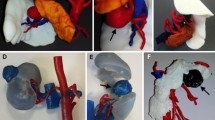Abstract
Background
The aim of the present study was to develop a unique anatomic replica of the mesocolon using digital graphical software in order to provide an educational template for mesosigmoidectomy.
Methods
The colon and mesocolon were fully mobilized from ileocecal to mesorectal levels in a cadaver. Both colon and mesocolon provided a template from which to generate a three dimensional replica in ZBrush. The model was deformed in ZBrush, to compare and contrast current and classic interpretations of mesosigmoidal topography. An animation was developed in which the replica was deformed to mimic operative mobilization. Contiguous shape changes were captured in two-and-a-half-dimensional (2.5D) screen snapshots. This was repeated for medial to lateral and lateral to medial mobilization of the mesosigmoid.
Results
Topographic differences between classic and current appraisals of mesocolic anatomy were evident in 2.5D format. Using the model generated, contiguous shape changes during mesosigmoidal mobilization (i.e., between the left mesocolon, mobile/apposed mesosigmoid, and mesorectum) were replicated in animation format. By extracting and compiling 2.5D screen grabs a pictorial chronology of mobilization was developed.
Conclusions
Recent advances in mesocolic topography can be captured and rendered using advanced digital sculpting software with high-end graphics capabilities. This approach permits a depiction of contiguous changes in mesosigmoidal topography during mesosigmoidal mobilization. A compilation of images in either animation or screen grab format obviates the interpolation of shape changes required using standard educational approaches.




Similar content being viewed by others
References
Culligan K, Coffey JC, Kiran RP et al (2012) The mesocolon: a prospective observational study. Colorectal Dis 14:421–430
Treves F (1885) Lectures on the anatomy of the intestinal canal and peritoneum in man. Br Med J 1:580–583
Ellis H (2010) The abdomen and pelvis. In: Ellis H (ed) Clinical anatomy: applied anatomy for students and junior doctors, 12th edn. Blackwell Science, Oxford, p 86
McMinn RH (1994) The gastrointestinal tract. In: McMinn RH (ed) Last’s anatomy: regional and applied, 9th edn. Langman Group Ltd, London, pp 331–342
Adams A, McConnell T (1923) Abnormalities of fixation of the ascending colon: the relation of symptoms to anatomical findings. Br J Surg 10:532–557
Standring S (2008) Large intestine. In: Standring S (ed) Gray’s anatomy: the anatomical basis of clinical practice, 40th edn. Churchill Livingstone, Philadelphia, p 1137
Agur AM (2008) The abdomen. In: Agur AMR (ed) Grant’s Atlas of anatomy. Williams and Wilkins, New York, pp 77–147
Bailey FR, Miller AM (1921) Text-book of embryology, Chap. 14. William Wood and Co., New York
Jorge JM, Habr-Gama A (2007) Anatomy and embryology of the colon, rectum and anus. In: Church JM, Garcia-Aguilar J, Roberts PL (eds) The ASCRS textbook of colon and rectal surgery, 3rd edn. Springer, New York, pp 1–22
Netter FH (2007) Abdomen. In: Netter FH (ed) Atlas of human anatomy. Saunders, Philadelphia, pp 270–274
Dodds WJ, Darweesh MA, Lawson TL et al (1986) The retroperitoneal spaces revisited. AJR 147:1155–1161
Rubenstein WA, Whalen JP (1986) Extraperitoneal spaces. AJR 147:1162–1164
Dodds WJ (1987) Retroperitoneal compartmental anatomy. AJR 148:829
Culligan K, Remzi FH, Soop M et al (2013) Review of nomenclature in colonic surgery—proposal of a standardised nomenclature based on mesocolic anatomy. Surgeon 11:1–5
Heald RJ, Husband EM, Ryall RD (1982) The mesorectum in rectal cancer surgery—the clue to pelvic recurrence? Br J Surg 69:613–616
Cameron J, Landau J (2009) Avatar. Lightstorm Entertainment, Dune Entertainment, Ingenious Film Partners, Twentieth Century Fox
Wu FTH, Ng-Thow-King V, Singh K et al (2007) Computational representation of the aponeuroses as NURBS surfaces in 3D musculoskeletal models. Comput Methods Progr Biomed 88:112–122
Toldt C (1879) Bau und wachstumsveranterungen der gekrose des menschlischen darmkanales. Denkschrdmathnaturwissensch 41:1–56
Toldt C (1919) An atlas of human anatomy for students and physicians, vol 4.408
Heald RJ (1988) The ‘Holy Plane’ of rectal surgery. J R Soc Med 81:503–508
Conflict of interest
None.
Author information
Authors and Affiliations
Corresponding author
Electronic supplementary material
Below is the link to the electronic supplementary material.
Supplemental File 1 video depicting the 3D model of the entire mesocolon and the ability to change the topography of the sigmoid mesocolon. The retroperitoneal structures and their relationship to the sigmoid mesocolon are included. (MP4 12799 kb)
Rights and permissions
About this article
Cite this article
Peirce, C., Burton, M., Lavery, I. et al. Digital sculpting in surgery: a novel approach to depicting mesosigmoid mobilization. Tech Coloproctol 18, 653–660 (2014). https://doi.org/10.1007/s10151-013-1116-6
Received:
Accepted:
Published:
Issue Date:
DOI: https://doi.org/10.1007/s10151-013-1116-6




